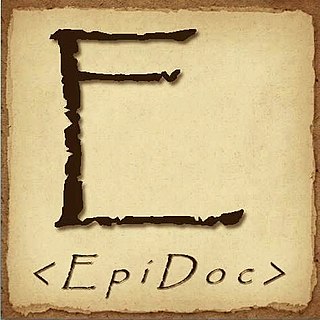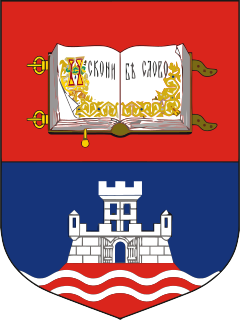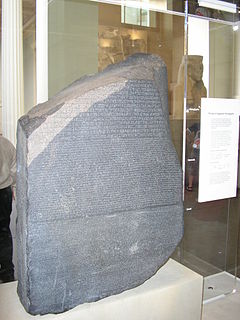
The Triballi were an ancient tribe whose dominion was around the plains of modern southern Serbia and western Bulgaria, at the Angrus and Brongus and the Iskar River, roughly centered where Serbia and Bulgaria are joined.

The Scordisci were a Celtic Iron Age tribe centered in the territory of present-day Serbia, at the confluence of the Savus (Sava), Dravus (Drava) and Danube rivers. They were historically notable from the beginning of the third century BC until the turn of the common era. The Scordisci consolidated into a tribal state. At their zenith, their core territory stretched over regions comprising parts of present-day Serbia, Croatia, Bulgaria and Romania, while their influence spread even further. After the Roman conquest in the 1st century AD, their territories were included into the Roman provinces of Pannonia, Moesia and Dacia.

The EpiDoc Collaborative, building recommendations for structured markup of epigraphic documents in TEI XML, was originally formed in 2000 by scholars at the University of North Carolina at Chapel Hill: Tom Elliott, the former director of the Ancient World Mapping Center, with Hugh Cayless and Amy Hawkins. The guidelines have matured considerably through extensive discussion on the Markup list and other discussion fora, at several conferences, and through the experience of various pilot projects. The first major—but not by any means the only—epigraphic project to adopt and pilot the EpiDoc recommendations were the Inscriptions of Aphrodisias and Vindolanda Tablets Online in 2002-4, and the guidelines reached a degree of stability for the first time in that period. EpiDoc has since been adopted as the native format for the Greek Papyrology site, Papyri.info.

Émmanuel-Édouard Chavannes was a French Sinologist and expert on Chinese history and religion, and is best known for his translations of major segments of Sima Qian's Records of the Grand Historian, the work's first ever translation into a Western language.
The Leiden Conventions are an established set of rules, symbols, and brackets used to indicate the condition of an epigraphic or papyrological text in a modern edition. In previous centuries of classical scholarship, scholars who published texts from inscriptions, papyri, or manuscripts used divergent conventions to indicate the condition of the text and editorial corrections or restorations. The Leiden meeting was designed to help to redress this confusion.

The École du Louvre is an institution of higher education located in the Aile de Flore of the Louvre Palace in Paris, France. It is dedicated to the study of archaeology, art history, anthropology and epigraphy.
The Greek-language inscriptions and epigraphy are a major source for understanding of the society and history of ancient Greece and other Greek-speaking or Greek-controlled areas. Greek inscriptions may occur on stone slabs, pottery ostraca, ornaments, and range from simple names to full texts.
Dineshchandra Sircar was an epigraphist, historian, numismatist and folklorist, known particularly in India and Bangladesh for his work deciphering inscriptions. He was the Chief Epigraphist of the Archaeological Survey of India (1949-1962), Carmichael Professor of Ancient Indian History and Culture at the University of Calcutta (1962–1972) and the General President of the Indian History Congress. In 1972, Sircar was awarded the Sir William Jones Memorial Plaque.

Otto Hirschfeld was a German epigraphist and professor of ancient history who was a native of Königsberg.
Margherita Guarducci was an Italian archaeologist, classical scholar and epigrapher. She was a major figure in several crucial moments of the 20th century academic community. A student of Federico Halbherr, she edited his works after his death. She was the first woman to lead archaeological excavations at the Vatican, succeeding Ludwig Kaas, and completed the excavations on Saint Peter's tomb, discovering relics she asserted were those of Saint Peter. She has asserted that the inscription on the Praeneste fibula is a forgery.
The Canadian Centre for Epigraphic Documents (CCED) is a non-profit organization founded in order to archive, catalog, and digitize epigraphic materials. The CCED is staffed by professionals and graduate student volunteers from the information field: librarians, archivists, and digital humanists.

Moesia Prima was a frontier province of the late Roman Empire, situated in the central parts of present-day Serbia, along the south bank of the Danube River. Provincial capital was Viminacium, near modern Kostolac in Serbia).

Max van Berchem was a Swiss epigraphist and historian. Best known as a pioneer of Arabic epigraphy, he created "Corpus Inscriptionum Arabicarum", an impressive collection of Arabic inscriptions.
Nikola Vulić ; was a Serbian historian, classical philologist, prominent archaeologist, doctor of philosophy and professor at the University of Belgrade. His new critical approach to archeological sources and strict methodology have made him a paragon for the forthcoming generations of researchers. In Serbia the pioneer in archeology and Illyriology was Mihailo Valtrović, but there was no widespreat activity until Nikola Vulić appeared, and brought important results in the half of the nineteenth century.
Émile Espérandieu was a French military officer, Latin epigrapher and archaeologist.

René Cagnat was a French historian, a specialist of Latin epigraphy and history of North Africa during Antiquity.
Laïla Nehmé is a Lebanese-French archaeologist. She is a specialist in the archaeology and epigraphy of the Ancient Near East, known for her research on Nabatean writings, the evolution of the Nabatean script into the Arabic, and archaeological excavations at Petra and Mada'in Saleh.
The gens Sabinia, occasionally written Sabineia, was a minor plebeian family at ancient Rome. Only a few members of this gens are mentioned in history, but others are known from inscriptions. Titus Sabinius Barbarus attained the consulship in the reign of Hadrian.














